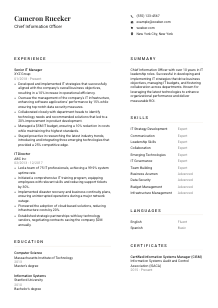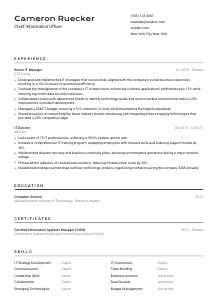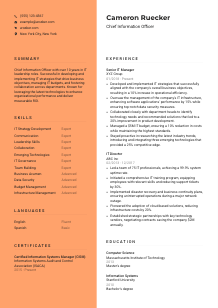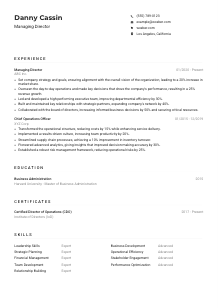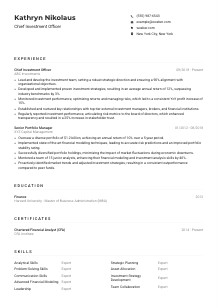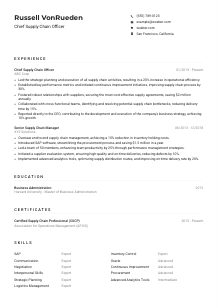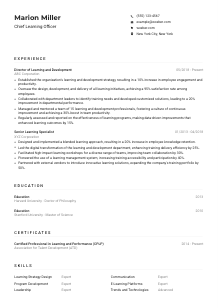Chief Information Officer Resume Example
Driving digital strategies, but your resume feels analog? Navigate through this Chief Information Officer resume example, orchestrated with Wozber free resume builder. Grasp how you can blend your tech leadership finesse with job specifications, ensuring your career trajectory is as cutting-edge as the solutions you deploy!
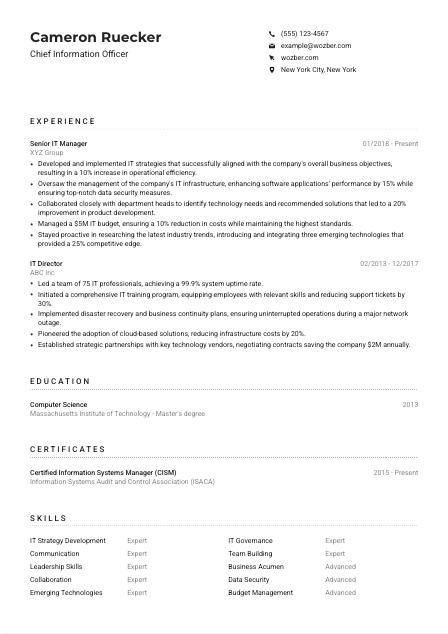
How to write a Chief Information Officer Resume?
In the realm of technology leadership, where innovation and strategic insight pave the path to success, your resume serves as the gateway. As a prospective Chief Information Officer, your challenge is not just to demonstrate your technical prowess but to encapsulate your strategic vision and leadership qualities. Armed with Wozber's free resume builder, you're about to craft an ATS-optimized resume that not only meets but exceeds expectations.
Ready to wield your professional narrative with precision and passion? Let's transform your resume into a magnetic testament to your CIO capabilities.
Personal Details
Even in the high-stakes world of technology leadership, the journey begins with the basics. Here, let's refine how to present your personal details in a manner that aligns seamlessly with your aspirations for the Chief Information Officer role.
1. Assert Your Identity
Your name, the masthead of your professional story, should be prominently displayed. Ensure it's in a clean, professional font, setting the stage for your candidacy as a Chief Information Officer. In this tech-savvy role, a professional email and perhaps a LinkedIn profile reflect your connectedness in the digital sphere.
2. Job Title Precision
"Chief Information Officer" right below your name acts as a declaration of intent. It mirrors your ambition and aligns squarely with the role you're eyeing. This precise alignment ensures you're seen as a tailored fit right from the start.
3. Critical Contact Information
In the digital age, your contact information serves as your beacon. A professional email formatted as firstname.lastname@email.com reaffirms your professionalism. Adding a phone number ensures direct communication channels are clear and open.
4. Geographic Synergy
Location matters, especially when the job stipulates it. Indicating "New York City, New York," as per the job description's requirement, instantly showcases your logistical compatibility, erasing any doubts about relocation or availability.
5. Digital Presence
A link to a professional website or portfolio, if you have one, can offer a deeper dive into your career achievements and vision. This is particularly compelling for a CIO role, where digital transformation and innovation are key.
Takeaway
Your personal details are more than mere formalities; they are your digital handshake with potential employers. Crafted with care, they set a professional, precise tone that aligns with your target role. Think of this section as your resume's foundation, supporting the narrative of you as the ideal Chief Information Officer candidate.





Experience
Illuminate your career path with a spotlight on transformative IT leadership that makes you the unequivocal choice for Chief Information Officer. Here's how to distill your extensive background into a compelling case for why you're the strategic visionary for the job.
- Developed and implemented IT strategies that successfully aligned with the company's overall business objectives, resulting in a 10% increase in operational efficiency.
- Oversaw the management of the company's IT infrastructure, enhancing software applications' performance by 15% while ensuring top‑notch data security measures.
- Collaborated closely with department heads to identify technology needs and recommended solutions that led to a 20% improvement in product development.
- Managed a $5M IT budget, ensuring a 10% reduction in costs while maintaining the highest standards.
- Stayed proactive in researching the latest industry trends, introducing and integrating three emerging technologies that provided a 25% competitive edge.
- Led a team of 75 IT professionals, achieving a 99.9% system uptime rate.
- Initiated a comprehensive IT training program, equipping employees with relevant skills and reducing support tickets by 30%.
- Implemented disaster recovery and business continuity plans, ensuring uninterrupted operations during a major network outage.
- Pioneered the adoption of cloud‑based solutions, reducing infrastructure costs by 20%.
- Established strategic partnerships with key technology vendors, negotiating contracts saving the company $2M annually.
1. Dissect the Role
Glean insights from the job description, identifying key phrases like 'developing IT strategies' and 'managing IT infrastructures.' Your experience should herald your successes in these areas, portraying you not just as a manager, but as a leader who propels business objectives through technology.
2. Construct a Narrative
List your roles in reverse-chronological order, spotlighting your evolution through strategic IT initiatives. Each position should reveal a chapter of growth, challenge, and achievement, culminating in your readiness for the CIO mantle.
3. Stories of Achievement
Shape your accomplishments into narratives that resonate with the central responsibilities of a CIO. Recount projects where you've spearheaded IT solutions that elevated business performance, integrating quantifiable outcomes to provide context and scale to your achievements.
4. A Numbers Game
Quantify your successes to lend credibility and scale to your narrative. Whether it's enhancing operational efficiency by 10% or saving the company $2M through strategic partnerships, numbers speak volumes of your impact and foresight.
5. Relevance Rules
Filter your experiences through the lens of the CIO role, ensuring each bullet point reinforces your candidacy. Extraneous details, however noteworthy, should be set aside in favor of those that strengthen your connection to the specific responsibilities and requirements of the job.
Takeaway
Your experience section isn't just a record of your employment history, it's a testament to your strategic impact in the IT realm. Tailored to reflect the specific nuances of the Chief Information Officer role, it should make the case, unequivocally, that your leadership can guide a company into its digital future. Lean on the power of storytelling and quantifiable achievements to elevate your narrative.
Education
The corridors of academia laid the groundwork for your ascent in the IT leadership ladder. Now, let's align your educational credentials with the Chief Information Officer role, ensuring they underscore your technical foundation and strategic acumen.
1. Spotlight Key Degrees
Directly addressing the job's requirement, lead with your most relevant degrees. For someone targeting a CIO role, your Bachelor's in Information Systems and Master's in Computer Science are not just qualifications—they're proof of your deep-rooted technical expertise.
2. Structure for Clarity
Lay out your academic credentials in an easy-to-follow format, with degree, field of study, and institution prominently displayed. This clarity not only aids in readability but places emphasis on the alignment between your education and the expectations for a CIO.
3. Degree Specificity
Your Master's degree in Computer Science, in particular, should be spotlighted. It positions you not just as someone with advanced IT knowledge, but as a leader prepared to leverage that knowledge in strategic, organizational contexts.
4. Relevant Extras
While the core of your education section should revolve around your degrees, don't overlook additional accolades or activities that reinforce your leadership and technological prowess—be it honors awards or noteworthy projects that align with strategic IT leadership.
5. Higher Learning
Consider including any ongoing education or executive leadership programs you're part of. Continuous learning is crucial for tech leaders, showcasing your commitment to staying at the forefront of technological trends and leadership best practices.
Takeaway
In the dossier of a Chief Information Officer candidate, the education section is more than just a formality. It's a declaration of your technical foundation and strategic potential. Craft this section to resonate with the benchmarks of the role, underlining your preparedness to lead at the intersection of technology and business.
Certificates
In the ever-evolving tech landscape, continuous learning is not just an asset; it's a necessity. Here's how to showcase your certifications in a way that elevates your Chief Information Officer candidacy, reflecting your commitment to excellence and innovation.
1. Align with Expectations
While the job description may not have listed specific certifications, highlighting ones like 'Certified Information Systems Manager (CISM)' directly correlates with the advanced responsibilities of a CIO, emphasizing your leadership and technical acumen.
2. Curate with Purpose
Focus on featuring certifications that are most relevant to the Chief Information Officer role. This targeted approach not only declutters your resume but ensures that each credential you list reinforces your expertise and suitability for the position.
3. Showcase Current Knowledge
Ensure your certifications are up-to-date, reflecting your commitment to staying abreast of the latest in IT governance, security, and strategy—all critical components of the CIO role. Recent certifications suggest a proactive approach to your professional development.
4. Commit to Continual Growth
Position yourself as a leader who values continuous improvement and learning. Mention any in-progress certifications or relevant courses, indicating your ongoing commitment to enhancing your expertise in line with the dynamic demands of the Chief Information Officer position.
Takeaway
Your certifications are badges of your commitment to professional excellence and continuous learning. For a Chief Information Officer, they signal your readiness to lead and innovate within the rapidly changing technology landscape. Choose and present them thoughtfully, painting a picture of a tech leader who is always ahead of the curve.
Skills
The toolkit of a Chief Information Officer extends beyond mere technical prowess to encompass strategic vision, leadership, and a nuanced understanding of business objectives. Let's finesse your skills section to portray the breadth and depth of your competencies.
1. Extract from Essentials
From 'IT Strategy Development' to 'Emerging Technologies,' select skills that match the responsibilities outlined in the job description. This direct correlation not only satisfies ATS requirements but immediately signals your alignment with the role's demands.
2. Balance the Technical and the Tactical
A successful CIO marries tech savviness with strategic decision-making. Ensure your skills reflect this duality—interlace your technological expertise ('Data Security', 'Infrastructure Management') with strategic and leadership skills ('Business Acumen', 'Team Building').
3. Clarity and Conciseness
In a landscape of infinite skills, prioritize those that best speak to your qualifications for the CIO role. A curated list demonstrates your understanding of the role's core requirements and your capacity to meet them head-on.
Takeaway
Your skills section is a concise exhibit of your professional arsenal. Tailored to reflect the Chief Information Officer role, it should balance technical expertise with strategic and leadership capabilities. This harmony of skills is what defines a successful CIO, and presenting them adeptly sets you apart as a visionary leader poised for impact.
Languages
In a globally intertwined corporate world, the ability to communicate across cultural and linguistic barriers is invaluable. Especially for a Chief Information Officer, who may oversee global IT operations, your linguistic acumen can be a distinctive asset.
1. Job Specification Alignment
With 'High level of fluency in English required' as a mandate, your language proficiency in English showcases more than your ability to communicate—it signals your readiness to lead in an international corporate environment.
2. Prioritize Relevant Languages
Highlight languages essential for the role at the top. Your fluency in English, coupled with additional languages, underscores your capability to navigate global IT challenges and foster multicultural team collaborations.
3. Include Other Linguistic Skills
Even if not explicitly required, additional languages enrich your portfolio, reflecting your versatility and global perspective—qualities befitting the role of a Chief Information Officer in a multinational corporation.
4. Authenticity in Proficiency
Be clear and honest about your language levels. Using standardized terms like 'Fluent' or 'Basic' to describe your proficiency avoids ambiguity and portrays you as a grounded and trustworthy leader.
5. Role's Global Nature
For positions with international exposure or clients, multilingual abilities enhance your leadership toolkit. They are not just languages; they are tools that unlock innovation and collaboration across borders, enhancing your effectiveness as a Chief Information Officer.
Takeaway
Your multilingual capabilities are a testament to your ability to lead and inspire in a diverse, globalized world. As you aspire to the Chief Information Officer role, let your language skills highlight your capacity for global perspective and cultural agility. They are key to navigating the international dimensions of technology leadership.
Summary
The opening of your resume is more than just a few lines of text—it's your moment to captivate, to succinctly convey your narrative as a strategic leader poised for the Chief Information Officer role. Let's sculpt a summary that encapsulates your breadth of experience and vision.
1. Grasp the Core Requirements
Digest the role's essential responsibilities and desired attributes. Your summary should echo the dedication and strategic insight of a Chief Information Officer, ready to drive technology solutions that align with business objectives.
2. Introduce Your Professional Self
Begin with a powerful statement that introduces you as a seasoned professional in the IT field. Highlighting over '10 years in IT leadership roles', sets the stage for a narrative of experience, growth, and resilience.
3. Spotlight Your Unique Influence
Mention key skills and achievements that reflect the job requirements. Phrases like 'successful in developing and implementing IT strategies that drive business objectives' directly address the role's key demands, positioning you as the ideal candidate.
4. Brevity is King
Your summary is the trailer, not the feature film. Keep it concise but impactful, offering a glimpse of your qualifications and exciting the reader to dive into the details. Three to five compelling lines are your canvas to intrigue and assure the hiring manager of your fit for the CIO role.
Takeaway
Your summary is the first handshake with potential employers, an opportunity to make a memorable impact. Tailoring it to the Chief Information Officer role, it should articulate not only your eligibility but your eagerness to drive technological innovation and strategic growth. Let it be a compelling prologue to the story of your professional journey.
Launching Your Chief Information Officer Journey
As we bring this guide to a close, remember, crafting a tailored Chief Information Officer resume with Wozber isn't just about landing a job—it's about asserting your place in the vanguard of technology leadership. Your resume is your banner in the digital arena, a blend of your strategic vision and technological expertise. With the insights shared, coupled with Wozber's ATS-friendly resume format and ATS optimization tools, you're equipped to craft a resume that doesn't just pass through algorithms but resonates with human aspirations and business objectives.
Step forth with confidence, your narrative is compelling, and the CIO chair awaits your leadership.

- Bachelor's degree in Computer Science, Information Systems, or a related field.
- Master's degree preferred.
- Minimum of 10 years of relevant IT experience, with at least 5 years in a leadership position.
- Proven track record in developing and implementing IT policies and systems that meet business objectives.
- Strong business acumen with a focus on delivering technology solutions that drive ROI.
- Exceptional communication, interpersonal, and leadership skills to foster a collaborative work environment.
- High level of fluency in English required.
- Must be located in New York City, New York.
- Develop and implement IT strategies aligning with the overall business objectives.
- Oversee the management of the company's IT infrastructure, software applications, and data security to ensure optimal performance and integrity.
- Collaborate with department heads to identify technology needs and recommend potential solutions or upgrades for both operations and products.
- Manage the IT budget, ensuring cost-effectiveness and value for money on IT expenditures.
- Stay updated on the latest industry trends and emerging technologies, providing insights and recommendations to the executive team.





